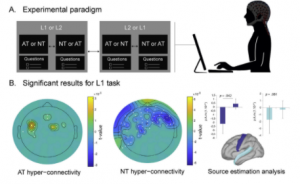The embodied penman: Effector-specific motor-language integration during handwriting
Cognitive Science
Afonso, O., Suárez-Coalla, P., Cuetos, F., Ibáñez, A., Sedeño, L. & García, A. M. (2019). The embodied penman: Effector-specific motor-language integration during handwriting. Cognitive Science 43(7), e12767. Online: http://bit.ly/327JZ05.
En este estudio investigamos correlatos electrofisiológicos de la lectura de narrativas naturalistas en bilingües. En la lengua materna (español), la lectura de textos de acción (ricos en descripción de movimientos corporales) implicó aumentos de conectividad específicos entre electrodos asociados a procesos motores. En la lengua extranjera (inglés), dicho patrón se vio asociado positivamente con la competencia en el idioma y negativamente con su edad de adquisición. Así, la reactivación de mecanismos corporizados durante la lectura se relacionaría con cuándo y qué tan robustamente incorporamos determinada lengua.
Para acceder al artículo completo hace click AQUÍ
The embodied penman: Effector-specific motor-language integration during handwriting
Cognitive Science
Afonso, O., Suárez-Coalla, P., Cuetos, F., Ibáñez, A., Sedeño, L. & García, A. M. (2019). The embodied penman: Effector-specific motor-language integration during handwriting. Cognitive Science 43(7), e12767. Online: http://bit.ly/327JZ05.
Several studies have illuminated how processing manual action verbs (MaVs) affects the programming or execution of concurrent hand movements. Here, to circumvent key confounds in extant designs, we conducted the first assessment of motor–language integration during handwriting—a task in which linguistic and motoric processes are co‐substantiated. Participants copied MaVs, non‐manual action verbs, and non‐action verbs as we collected measures of motor programming and motor execution. Programming latencies were similar across conditions, but execution was faster for MaVs than for the other categories, regardless of whether word meanings were accessed implicitly or explicitly. In line with the Hand‐Action‐Network Dynamic Language Embodiment (HANDLE) model, such findings suggest that effector‐congruent verbs can prime manual movements even during highly automatized tasks in which motoric and verbal processes are naturally intertwined. Our paradigm opens new avenues for fine‐grained explorations of embodied language processes.
To access the full paper please click here


